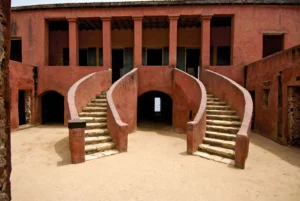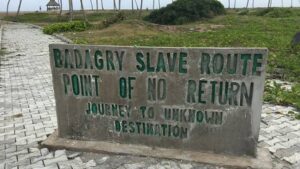The Transatlantic Slave Trade stands as one of the darkest chapters in human history, leaving an indelible mark on the continents of Africa, Europe, and the Americas.
This abhorrent practice involved the forceful transportation of millions of Africans to the Americas, where they endured unimaginable suffering and exploitation.
Below, we will delve into the most notorious slave trade locations, shedding light on the historical significance of these sites that witnessed the tragic trade between Africans and Europeans.
- Goree Island, Senegal: A Gateway to Despair

- Elmina Castle, Ghana: Echoes of Suffering
 Nestled along the coast of Ghana, Elmina Castle is a stark testament to the brutality of the transatlantic slave trade. Built by Portuguese traders in the 15th century, the castle became a hub for the transshipment of enslaved Africans to the Americas. Its cramped dungeons and infamous Door of No Return symbolize the dehumanization and despair faced by those who were forcibly taken from their homeland.
Nestled along the coast of Ghana, Elmina Castle is a stark testament to the brutality of the transatlantic slave trade. Built by Portuguese traders in the 15th century, the castle became a hub for the transshipment of enslaved Africans to the Americas. Its cramped dungeons and infamous Door of No Return symbolize the dehumanization and despair faced by those who were forcibly taken from their homeland.
Also, read; Senegal’s Presidential Election Postponed Indefinitely by President Macky Sall
- Cape Coast Castle, Ghana: A Portal to Darkness
 Adjacent to Elmina Castle, Cape Coast Castle served as another harrowing site for the trading of human lives. Its dungeons, similar to those of Elmina, held thousands of Africans before their journey across the Atlantic. The “Door of Return,” installed in recent years, serves as a symbolic entry point for descendants of enslaved Africans seeking to reconnect with their roots.
Adjacent to Elmina Castle, Cape Coast Castle served as another harrowing site for the trading of human lives. Its dungeons, similar to those of Elmina, held thousands of Africans before their journey across the Atlantic. The “Door of Return,” installed in recent years, serves as a symbolic entry point for descendants of enslaved Africans seeking to reconnect with their roots.
- Badagry, Nigeria: The Journey Begins
 Badagry, a coastal town in Nigeria, was a significant starting point for many Africans on their way to slavery. The town is home to the Point of No Return, a somber landmark marking the final departure point for countless enslaved individuals. The Mobee Family Slave Relics Museum in Badagry preserves artifacts and stories, ensuring that the painful history of the transatlantic slave trade remains vivid in the collective memory.
Badagry, a coastal town in Nigeria, was a significant starting point for many Africans on their way to slavery. The town is home to the Point of No Return, a somber landmark marking the final departure point for countless enslaved individuals. The Mobee Family Slave Relics Museum in Badagry preserves artifacts and stories, ensuring that the painful history of the transatlantic slave trade remains vivid in the collective memory.
- Zanzibar, Tanzania: The East African Connection
 While much focus is often on West Africa in discussions of the transatlantic slave trade, Zanzibar, located off the East African coast, played a crucial role in the Arab slave trade. The island’s Stone Town holds remnants of the past, including slave chambers and marketplaces. These locations bear witness to the exploitation and suffering experienced by countless East Africans at the hands of Arab slave traders.
While much focus is often on West Africa in discussions of the transatlantic slave trade, Zanzibar, located off the East African coast, played a crucial role in the Arab slave trade. The island’s Stone Town holds remnants of the past, including slave chambers and marketplaces. These locations bear witness to the exploitation and suffering experienced by countless East Africans at the hands of Arab slave traders.
- Bunce Island, Sierra Leone: A Trading Post of Despair
 Bunce Island, nestled in the Sierra Leone River, served as a notorious British slave trading post during the 18th century. The island became a hub for capturing and detaining Africans before shipping them across the Atlantic. The remnants of the slave fortress on Bunce Island tell a harrowing tale of the brutal conditions endured by those awaiting the treacherous journey to the Americas.
Bunce Island, nestled in the Sierra Leone River, served as a notorious British slave trading post during the 18th century. The island became a hub for capturing and detaining Africans before shipping them across the Atlantic. The remnants of the slave fortress on Bunce Island tell a harrowing tale of the brutal conditions endured by those awaiting the treacherous journey to the Americas.
- Ghana’s Assin Manso: The Slave River
 Assin Manso in Ghana bears witness to a different aspect of the transatlantic slave trade. Often referred to as “Donkor Nsuo” or Slave River, it served as a sacred site where enslaved Africans took their last bath on African soil before being marched to the coast. Today, the river is a memorial site, allowing visitors to reflect on the spiritual and emotional turmoil experienced by those about to face the horrors of slavery.
Assin Manso in Ghana bears witness to a different aspect of the transatlantic slave trade. Often referred to as “Donkor Nsuo” or Slave River, it served as a sacred site where enslaved Africans took their last bath on African soil before being marched to the coast. Today, the river is a memorial site, allowing visitors to reflect on the spiritual and emotional turmoil experienced by those about to face the horrors of slavery.
Conclusion:
Exploring the most infamous slave trade locations provides a sobering glimpse into the profound impact of the transatlantic slave trade on African societies. These sites stand as historical witnesses to the inhumanity, suffering, and resilience of those who endured one of the darkest periods in human history.
 As we delve into the past, it is essential to remember and honor the strength of the individuals who faced unimaginable hardship, contributing to a collective understanding of our shared history.
As we delve into the past, it is essential to remember and honor the strength of the individuals who faced unimaginable hardship, contributing to a collective understanding of our shared history.
